By Jeffrey A. Rendall, Photos by Jeffrey A. Rendall
MAKENA/WAILEA MAUI, HI – “I love Hawaii, it’s my favorite place on earth,” remarked Robert Trent Jones, Jr., in commenting on his work at Makena and Wailea – both of which occupy a beautiful piece of the Aloha State on the island of Maui’s south shore (near the central portion of the island).”
“When I’m down in the trenches working in dirt at other places, my mind often wanders to Princeville (on the island of Kauai) and Makena and Wailea,” Jones added.
That’s a high compliment from just about anyone, but when it comes to Jones, Jr., that’s saying even more – because he’s just a tad well-traveled. Most golf architects have worked internationally, but you’d be hard pressed to find a golf course designer who’s toiled in more places than Jones Jr. His portfolio includes designs in over forty countries and in over half of the United States – needless to say, he must know his way around airports by now.
How he arrived at Makena and Wailea also has an interesting story to it. As Jones Jr. tells it, he was familiar with the land that Makena occupies prior to it being developed into a golf resort. “I was working in Japan and doing some projects for a Japanese company in the late 60’s and 70’s – and they were interested in acquiring some property in Hawaii. I’d already done Princeville at that time, so they asked me if I could help them. I knew the party that owned the property which is now Makena – some beautiful land at the base of Haleakala volcano.”
A deal was struck and development began on the first layout at Makena in the early 80’s, with the course opening in 1982. The original eighteen consisted of what is now the back nine of the South Course (which is currently closed) and the first five holes and the final four on the North Course (now known as Makena Golf Course).
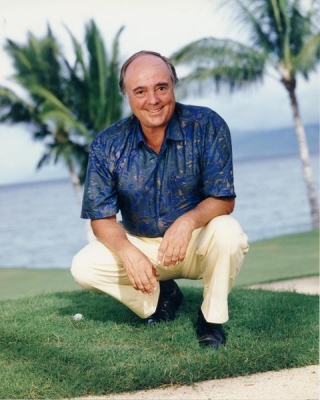 |
Ten years after the first course opened, Jones Jr. returned to Makena to construct another eighteen holes – which is now the front nine of the South Course and holes 6-14 on the North Course.
“They’re very different golf experiences,” Jones Jr. explained, in talking about the difference between Makena’s two courses. “One’s a traditional continuous eighteen like Pebble Beach or Cypress Point or St. Andrews or the traditional courses of Scotland or the British Isles (speaking of the North Course), and the other has returning nines, which is more American in content.”
Wailea was constructed around the same time as the second Makena eighteen, and occupies land that’s slightly farther north along the coastline – but you can easily call them neighbors.
Both are beautiful and memorable, and it’s easy to see why they’ve helped Jones Jr. become so fond of Hawaii. We caught up with him recently to talk about his work in Hawaii, and he also shared with us some of his philosophy on golf design that he’s accumulated over a lifetime of experience:
GTMA: What’s the status of the Makena South Course?
RTJ2: It’s now closed – they’re going through a foreclosure on the property, and it should be resolved by the end of May (2010). We started to remodel the course a second time (they’d refreshed the course in 2001, putting in new grasses), and then the financial crisis hit and the work stopped.
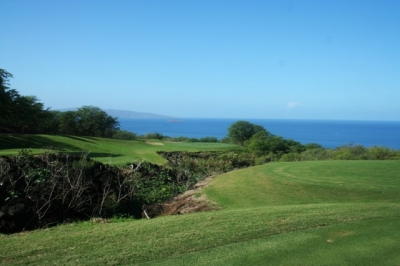 |
| Makena's par three 12th hole looks like it has trouble all-around, but with a view like this, it's hard to be upset if you mishit your tee shot. |
GTMA: Do you think there’s a chance it will remain closed permanently?
RTJ2: No, no I don’t.
I mean, if you’re getting your painting refreshed from Rembrandt, would you never put it up again?
This type of thing has happened before in the golf world, many times. When the communists took over in Portugal, the Troia course my father designed stopped for four years. When the Philippines were under martial law, many of the courses just stopped. It all comes back, because golf is stronger than all that stuff.
GTMA: Great to hear. Makena certainly is a special place. Going back to the early 90’s, what was your first impression of the mountainous land that now makes up the newest nine holes on the North Course?
RTJ2: Well, I’d known that land for a long time, I’d been all over it from the late 70’s on – so I knew the land was very dramatic. It’s rocky. It had some of those plants that bloom once every hundred years naturally.
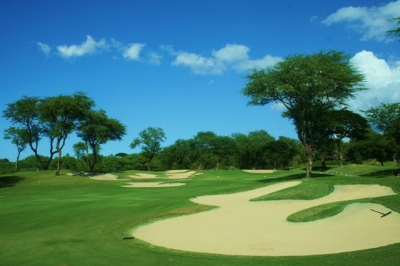 |
| Jones says Wailea Gold's par five 7th hole is an example of 'illusion,' with bunker placement where looks may be deceiving. |
It had fast rushing streams where there could be flooding. It’s kind of like a desert, with cactus out there, and there are all those Kiawe trees and other indigenous plants. But the fundamental point is, it’s a tossing, turning, rolling remnant of an old volcano.
So it has a links ‘style’ to it, naturally, from the sedimentation of the lava. And so it’s unusual.
The holes aren’t crafted links-style, it just is what it is. So we didn’t change anything – the big issue there was to find the routing within the land. That was the hard part, the intellectual part.
GTMA: It must have been quite an exercise on that land, for sure.
RTJ2: People always say, ‘oh, I could’ve figured out e = mc squared’ – well, nobody did.
So, and once you sort of reveal it, it seems obvious. But in the case of the North Course, it was hard – it starts off with a split fairway around a fast-rushing wash at times (the par four 6th hole). And then it reaches across and kind of step-ladders up the mountain.
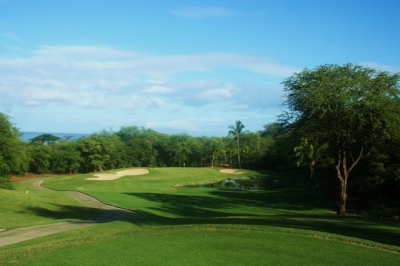 |
| Bunkers, a pond and different pin placements will make even a simple hole like Makena's par three 4th play differently every time. |
And then the routing begins to go slightly downhill – and then you play a par three (12th hole), then a very dramatic hole off the tee of the par five 14th, where there’s huge bunkering on the left side of the landing area and you can reach it in two. You know, the young limber backs can still do it, but distance and control is required.
It climbs up and then it dramatically comes down.
GTMA: Were there any special environmental concerns on either of the courses?
RTJ2: The word ‘environmental’ wasn’t as popular then as it is now. The answer is – we’ve always had the policy, I have had – of following the land.
If you read my works from way back in the 60’s, on my first course at Silverado (in Napa, California) – I left some stones unused in front of the sixth hole – and even then, my father criticized me. He said ‘what happens if a ball hits that stone and it ricochets back and hits somebody in the eye?
I said ‘well, I just think it’s the appropriate thing to do here.’
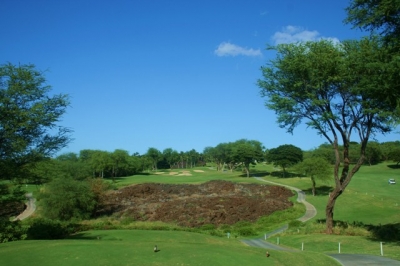 |
| It looks like a long carry of the tee of Wailea Gold's par four 9th hole, but it's actually very manageable from the correct tee box. |
So I’ve always been interested in leaving certain natural features of the land as an integral part of the design.
GTMA: Speaking of land features, there appears to be rock walls at both Makena and Wailea – did you feel a need to give them special treatment?
RTJ2: The rock walls are more extensive at Wailea, but there are some on the Makena South course along the 8th hole.
But whenever they’re there, we’ll incorporate them as a design element – but they are not sacred like Heiau (Hay-ow). And those rock walls may not have even been built by Hawaiians -- it might’ve been put in place in relatively modern times for cattle containment. So we may remove some of the rock wall and play through it as an artifact of the site rather than as an environmental or a conservation easement.
GTMA: Now, in terms of playability (on the Makena Golf Course), I certainly wouldn’t rate it as overly difficult, but in some areas up there, if you’re off the playing surface you’re basically gone. Was there any kind of a playability concern there?
RTJ2: No. It’s easy to design a very difficult golf course, or a hard course. It’s also easy to design an easy course.
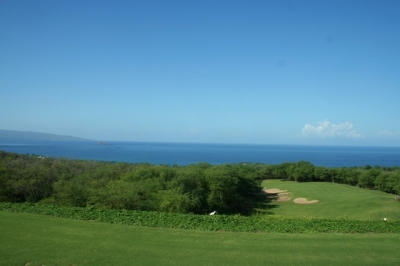 |
| Makena's long par five 14th hole measures over 600 yards, but Jones says it's reachable in two if you're accurate. |
The hard part for any project is to design an interesting course. And that was my attempt. It’s much more difficult to lay out eighteen little puzzles that hold your interest throughout a round. They’re puzzle pieces that have a rhythm of their own and make the picture, the cut-out.
I think that we achieved that at both Makena and Wailea. They follow the land, they have their own character, but they’re not like identical twins, but more like brother and sister twins.
GTMA: Kirk Nelson has been at Makena for years, and he mentioned that several of the holes are lined up with features on the land or islands out to sea – is that something you were trying to do?
RTJ2: Well, yes, but not precisely that.
When you open up a course and you see through the trees and the canopy – when you first go there, it’s rough. If you’re hiking around… people think I have this wonderful job because I go to golf courses all the time. But when I go there in the construction phase, they’re dirt, rocks and hiking boots, and when you fall down, it hurts – especially the spikes of the Kiawe trees.
But when you open up the land, we might adjust the orientation of the hole towards a feature in the background – that’s called a principle of harmony – and we do that. In Makena’s case, the 10th hole (South) goes straight toward the sea, and we almost had like stepping stones of lakes. There’s a lake right, a lake left, and then the ocean on the 10th hole of the South Course. That was intentional, to lead your eye in almost a watery stepping stone down to the sea and then beyond that there’s Molokini Island.
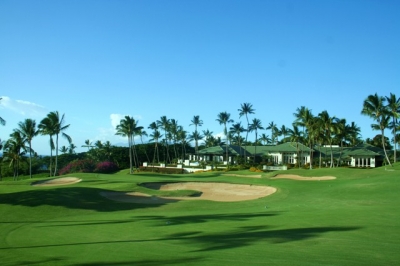 |
| Huge bunkers guard the green of Wailea Gold's par four 18th hole -- and there's a good look at the clubhouse in the background. |
And between those two places in March, the whales are jumping and you can see them. And then to the left of that there’s an existing cinder cone (Puu Olai) before you get to the Oneloa beach.
All of that’s very natural. And I think the course weaves around it, but it’s a very natural golf course. It’s set into its setting – it’s not trying to be crafted with a setting nearby.
I liken it to the difference between an unframed Monet painting and a poor painting with a Bernini golden frame. It’s a beautiful, beautiful site, but it’s beautiful in its own way.
GTMA: Does it bother you that Makena is not really walk-able? Some architects really favor walking, as a ‘traditional’ part of the game.
RTJ2: I don’t agree with that assessment – the South Course is easily walk-able.
And the North Course – yeah, it’s not as walk-able as the South Course, but it’s a golf course, it’s not a housing development. Therefore, you can go from the green to the next tee, and you can walk. There are a couple transition places like between the fifth green and the sixth tee – they’re uphill, and then downhill at 14.
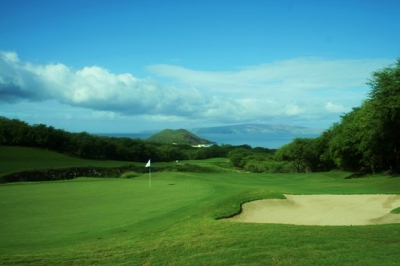 |
| Looking back from behind the green of Makena's par four 6th hole, you'll see the Puu Olai cinder cone in the background. |
But they’re not long walks. Maybe you have to be in a little better shape – be a western person who’s used to climbing up and down hills rather than an easterner on a flat Florida site. But a lot of people are in pretty good health out there in Maui. They can walk it.
Let me put it this way: if you ever tried to walk the Weiskopf courses at Yellowstone – you could not do that, because the transitions are so great. You need a way to get up and down like a ski lift to take you up there. But here, you can walk it if you choose to.
GTMA: How important in general is it to design a walk-able course?
RTJ2: I don’t think it’s important at all.
It’s the way the traditionalists like to play the game, and we’re not trying to make an unwalk-able golf course when we start laying it out.
All games are attack and defend, I like to say. And if you’re on the defensive side, which I am, you try to set up each hole to be an interesting attack for the players -- and if they succeed I want the course to yield. In order to do that, the hole has to work for golf.
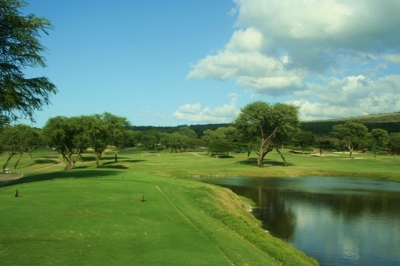 |
| Looking from the tee of Wailea Gold's par five 13th hole. |
It’s not only an aesthetic experience, a walk in the wilderness or the wild – but it’s also shot-values and shot-making. If you hit good shots, you want to have a good result, and you want the course to yield.
So, if you have to make a transition from one green to the next tee, which requires non-walking the way Weiskopf did – then we have something new in the game which wasn’t invented when the game was invented, namely the golf cart. So, we can do that now.
It’s the same way that defensive castle-builders, when they discovered gunpowder from China – they stopped using boiling oil as defenses because it didn’t work anymore.
GTMA: I don’t think I’ve ever heard it described quite that way.
RTJ2: Well, that’s my job as an artist.
GTMA: Speaking of art, what’s the background of your work at Wailea?
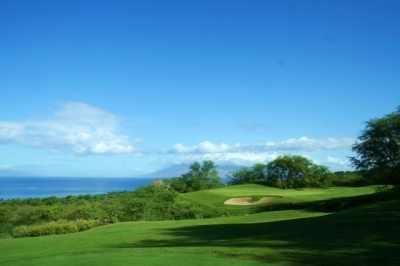 |
| It's hard to imagine a more tranquil scene than Makena's par three 7th hole. |
RTJ2: Well, there were 36 holes there before we started the project – the Blue Course and one other course. We ‘blew it up’ and it’s not there anymore (Ed note: The Blue Course is still at Wailea). We used part of that land for the Emerald and Gold courses, and then added more land to complete the project.
The Gold Course is a much more traditional straight-forward course. It tends to follow the back-and-forth on the terrain – in skiing, it would be like traversing the hill. It tends to traverse back and forth on the slope of the hill. Occasionally you turn and go uphill or go downhill, but it’s a very classic-style.
I modeled it and its bunkering and its greens on Winged Foot, where I grew up playing. I used strong bunkering, very artful bunkering – in-your-face bunkering, what we call ‘face’ bunkering, to intimidate you.
On the Gold course, you need very clear precision off the tee and in your approach shots to be rewarded – otherwise, you’ll be in a hazard.
And the Emerald course is the opposite – it’s loose off the tee, it changes direction quite a bit. The bunkers are removed from the targets so that the average player doesn’t find them. They may be there for turning a hole, or they may be there for a very poor shot – but for the most part, it’s a more relaxed examination of your game.
It’s also very popular with women because of the flower gardens and lakes and other things that are pleasing in a park-like setting.
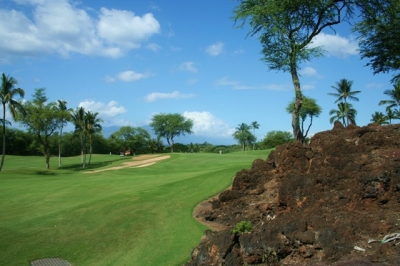 |
| Lava figures prominently into the design at Wailea's Gold Course. Here, the par three 3rd hole. |
GTMA: The Gold Course has obviously hosted some events – do you go into designing a course with the idea that ‘this needs to be more of a championship test’ to hold those types of events?
RTJ2: No. Every client is different and every piece of land is different, and, when I’m asked to do that – that’s exciting things to do.
But I’m not a golf professional, though I played for the U.S. team when I was a junior and I played first man at Yale – so I played competitively – but at that time, going into being a golf professional like Nicklaus did, who was my colleague at the same age, was not necessarily what you did.
So I followed my father’s footsteps after post-graduate work at Stanford, and basically went into the design business – or design and construct, actually.
To answer your question – the client and the land is everything. The land is the most important thing, and we try to serve the land – and in so serving the land we serve the client in our mind.
And if the client says ‘oh, I want a TPC course’ – I say, well, you better go talk to the TPC.
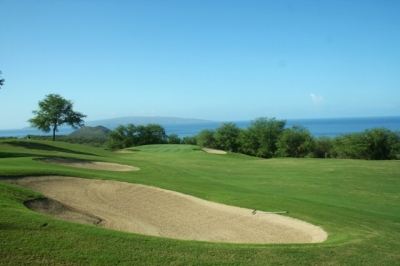 |
| The 13th hole at Makena is a short par four with risk-reward options off the tee. |
I will give you a course which can host championships, but if you’re trying to brand it – it’s something that I can’t do for you and you’ll be unhappy and I won’t have fulfilled my fiduciary duty that you’ve entrusted me with, with your land and your money and eventually it won’t be able to be maintained by your people.
But we work through that process, we give them alternatives and lead them towards a conclusion that is right for their land and their business mission and business plan.
GTMA: So what goes into making a championship golf course?
RTJ2: I’ve done many, many championship courses – and in my mind, the definition of a championship course is one upon which a championship has been played, not merely some theoretical one.
Now when we have an opportunity to work at the absolute highest skills levels of the game, such as we just did at Chambers Bay (in Washington state), for me, that’s a very fun and very challenging way to do architecture. Because then, we’re really dealing with the .1% of the game, and not everybody else.
And that’s very rare to do that. But unfortunately, in my opinion, many of the golf professionals, who have jumped into design in the ‘offensive’ way – they see it as make it hard, hard, hard, long, long, long, and I think they’ve taken the fun out of the game, and I think that’s part of the reason some courses are not doing well and the game has become less popular in the last couple years.
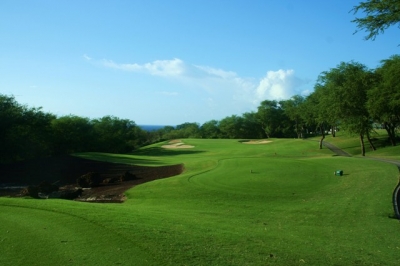 |
| Wailea Gold's par three 16th hole is Hawaiian golf at its finest. |
GTMA: How do you make it fun?
RTJ2: I design for the average people – and even if it’s a championship course… how would I explain that? In Chambers Bay for example, which is going to host the U.S. Amateur this year and the U.S. Open in 2015 -- there’s not a single water hole on the course. You can see Puget Sound, but there are no water hazards.
And, the fairways are sometimes 80 yards wide – okay, it is for the better players of the world 7650 yards, or even more depending on how they choose to set it up. But for the average player, they’re playing at where they should play at maybe 6500 on a very wide and forgiving course. And when you miss a shot you can go find your golf ball and go hit it again.
You can, at some sites, be flexible. You can’t do that if you’re trying to exploit it for housing. I call that ‘fairway robbery.’ So that’s a different kind of plan that is not working out very well right now for most people.
But for the most part I prefer the traditions of the game, I prefer a course that is what we call a ‘core’ course, where the golf course is for the game. And that’s what’s so good about Makena and Wailea, because there’s no housing.
There may be someday, but there isn’t now.
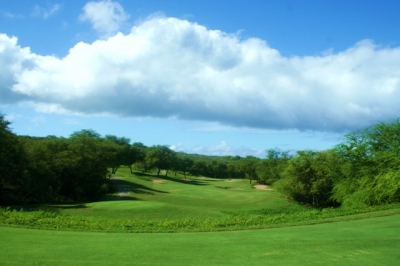 |
| Jones blends golf into the natural environment at Makena -- here, the par four 9th hole. |
GTMA: In terms of specifically Wailea, were there any difficulties that you had to overcome or any special environmental or historical considerations that you had to deal with?
RTJ2: Well, there were some walls there, as I recall. We were careful on the 10th hole of the Gold Course to preserve what was there.
We also a device on some of the holes – it’s called ‘illusion.’ On the par five seventh hole (Gold Course), you play parallel to the ocean, and the bunker in front of the green is 30 yards in front of it, yet from a distance, it looks like it’s snuggling up to the green itself. That’s another kind of defense, it’s a magician’s illusion.
And we’re saying ‘hey, you better believe your yardage book or your caddy or your Sky Caddie and select your club – don’t let your eye fool you here.’
It’s a little bit like a pilot flying on instruments, you’ve got to obey them.
Basically my attempt is to have you remember every hole you can. And each hole has a different mental challenge – it’s like outdoor chess. Because you have to think about your moves before you make them, and then you make them – and if you don’t make them you still can recover with a brilliant, thought-out second shot, a recovery shot.
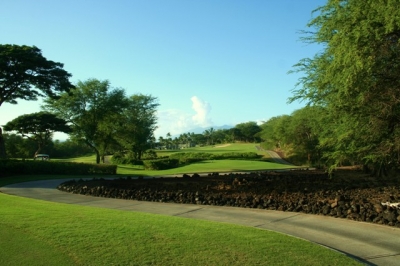 |
| As you reach the tee of Wailea Gold's par four 18th hole, you'll be hungering to come back for more another time. |
And then when you get on the greens, you’re still not done, I want you to putt. And I want you to think about the breaks, and then at the end of the day, if you’ve done all that, we’ve engaged you, you’ve forgotten about what time it is, you go and have a Mai Tai and watch the sunset which would wake up the soul of a mummy and have a memorable day.
________________________________________________________________________
Needless to say, Robert Trent Jones Jr. has a different way of describing his golf work – he sees it as art, and is worldly enough to put it in those terms.
Like his father and his brother (Rees Jones), Jones Jr.’s courses are aesthetically pleasing and fun to play – and memorable. Makena and Wailea are just two examples of Jones Jr.’s fine work, and with those resorts as an example, it’s easy to see why he loves the Hawaiian Islands so much.
Details:
Makena Golf Course
5415 Makena Alanui
Makena, Maui, HI 96753
FAX: (808) 879-2834
Assistant Golf Professional: Kirk Nelson, PGA
Championship 6567 135/72.0
Resort 6151 131/70.1 131/75.2
Forward 5303 120/70.5 118/66.5 (M)
Check the Website for current rates.
Wailea Golf Club’s Gold Course
100 Wailea Golf Club Drive
Wailea, HI (Maui) 96753-4000
Phone: (888) 328-MAUI
FAX: (808) 875-5114
Website: http://www.waileagolf.com/
Tees/Yardage/Slope/Rating
Blue 6653 136/71.4
White 6152 131/69.0
Red 5442/5317 121/124 70.3/71.0
| Related Links | Comments on this article? | |
|
Maryland National Golf Club Hollow Creek Golf Club Rocky Gap Resort PB Dye Golf Club in Ijamsville Whiskey Creek Golf Club |
E-mail Jeff Rendall, Editor: jrendall@golftheunitedstates.com |











